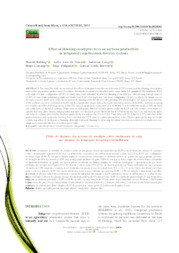Effect of thinning eucalyptus trees on soybean productivity in integrated crop-livestock-forestry systems.
Effect of thinning eucalyptus trees on soybean productivity in integrated crop-livestock-forestry systems.
Author(s): BEHLING, M.; SOUZA, A. L. de; LANGE, A.; CAMARGO, D.; BARRETO, G. U.
Summary: Abstract: The aim of the study was to evaluate the effects of integrated crop-livestock-forestry (ICLF) systems and the thinning of eucalyptus trees on the agronomical performance of soybean. Treatments consisted of cultivation under: crops under full sunlight (CFS) conditions; ICLF with triple-row tree configuration (ICLFT) in which trees were submitted to selective thinning in the fifth year after planting through removal of 50% of trees while maintaining triple-row bands; and ICLF with single-row tree band configuration (ICLFS) in which the lateral rows of the triple-row tree bands were subjected to systematic thinning at the fourth year after planting. The physiological and agronomical variables of the soybean crop were evaluated at the R5 and R8 reproductive stages during the eighth harvesting season (2018/2019). Soybean sampling was carried out at five random positions in the CFS and in four transects at distances of 3, 6, 10 and 15 m from the tree bands in both the north and south faces of the ICLF systems. There were no differences between soybean grown under the ICLF and CFS systems with respect to specific leaf area, plant density, lodging index and mass of a thousand grains. However, the ICLF increased dry leaf mass and leaf area index and reduced soybean plant heights. Soybean productivity was reduced by 26% in ICLF-T and 14% in ICLF-S, that is, a 12% reduction in the productivity loss with systematic thinning. It is concluded that ICLF reduces soybean productivity in the effective grain production area of the system, regardless of the degree of thinning, although systematic thinning by removing the lateral tree lines to conversion of triple-rows into single-rows minimizes the loss of soybean grain yield. | Resumo: O objetivo do trabalho foi avaliar o efeito da integração lavoura-pecuária-floresta (ILPF) e do desbaste das árvores de eucalipto sobre o desempenho agronômico da soja. Os tratamentos consistiram em cultivo convencional a pleno sol (CPS), ILPF com configuração de fileira tripla (ILPF-T), em que as fileiras triplas de árvores foram submetidas ao desbaste seletivo no quinto ano após o plantio por meio da remoção de 50% das árvores e ILPF com configuração de fileira simples (ILPF-S), em que as faixas triplas de árvores foram submetidas ao desbaste sistemático no quarto ano após o plantio resultando em fileiras simples. As variáveis fisiológicas e agronômicas da soja foram avaliadas nos estágios reprodutivos R5 e R8 durante a oitava safra (2018/2019). As amostragens de soja foram realizadas em cinco posições aleatórias no CPS, enquanto as coletas foram realizadas em quatro transectos a distâncias de 3, 6, 10 e 15 m das faixas das árvores nas faces norte e sul dos sistemas ILPF. Não houve diferenças entre a soja cultivada nos sistemas ILPF e CPS em relação à área foliar específica, densidade de plantas, índice de acamamento e massa de mil grãos. No entanto, a ILPF aumentou a massa de folhas secas e o índice de área foliar e reduziu as alturas das plantas de soja. No desbaste seletivo de 50% das árvores (ILPF-T) a perda de produtividade da soja foi de 26%, enquanto no desbaste sistemático (ILPF-S) ela foi de 14%, ou seja, redução de 12% na perda de produtividade da soja. Portanto, a ILPF reduz o rendimento de grãos da soja independente da intensidade do desbaste realizado e o desbaste sistemático, com remoção das linhas laterais para conversão do sistema para linhas simples (ILPF-S) proporciona menor perda de rendimento de grãos da soja.
Publication year: 2023
Types of publication: Journal article
Observation
Some of Embrapa's publications are published as ePub files. To read them, use or download one of the following free software options to your computer or mobile device. Android: Google Play Books; IOS: iBooks; Windows and Linux: Calibre.
Access other publications
Access the Agricultural Research Database (BDPA) to consult Embrapa's full library collection and records.
Visit Embrapa Bookstore to purchase books and other publications sold by Embrapa.

